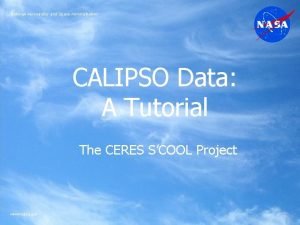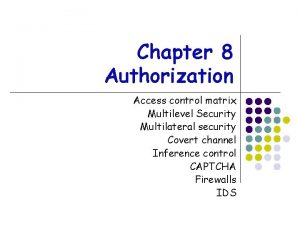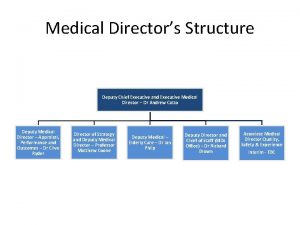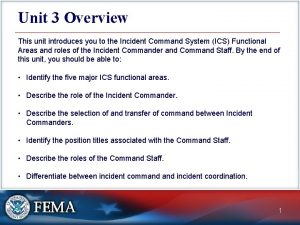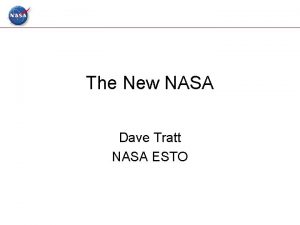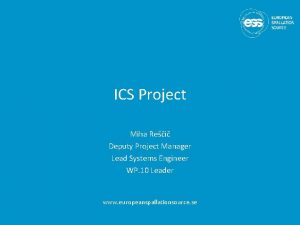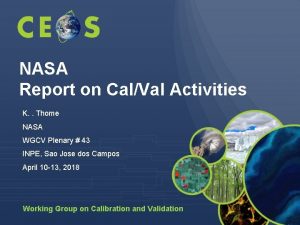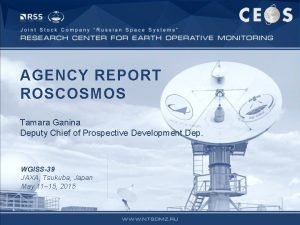NASA Agency Report Andrew Mitchell Deputy Project Manager










- Slides: 10

NASA Agency Report Andrew Mitchell Deputy Project Manager / Technical Earth Science Data and Information System (ESDIS) March 18, 2016 2/28/2021 1

NASA Earth Science Division (ESD) Overview • NASA ESD priorities: – advances Earth system science – delivers societal benefit through applications development and testing – provides essential global spaceborne measurements supporting science and operations – develops and demonstrates technologies for nextgeneration measurements, and – complements and is coordinated with activities of other agencies and international partners 2

NASA’s Earth Science Division Research Flight Applied Sciences Technology

Formulatio n Implementati on Primary Ops Extended Ops Landsat 9 PACE NI-SAR SWOT TEMPO JPSS-2 (NOAA) RBI, OMPSGRACE-FOLimb (2) ICESat-2 CYGNSS Sentinel 6 A/B Earth Science Instruments on ISS: IS S SORCE, NISTAR, EPIC TCTE (NOAA)(NOAA’S DSCOVR) Quik. SCAT Rapid. Scat, CATS, LIS, SAGE III (on ISS), TSIS-1, OCO-3, ECOSTRESS, GEDI, CLARREO-PF Landsat 7 SMAP Suomi NPP (NOAA) Landsat 8 (USGS) Terra (USGS) Aqua Cloud. S at CALIPS O GPM EO-1 Aura GRACE (2) OCO 2 OSTM/Jason 2 (NOAA)

NASA Earth Science Data System (ESDS) Program Vision Make NASA’s free and open earth science data interactive, interoperable and accessible for research and societal benefit today and tomorrow. 2/28/2021 5

ESDS Mission Statement The Earth Science Data System Program oversees the lifecycle of earth science data with the principle goal of maximizing the scientific return from NASA’s missions and experiments for research and applied scientists, decision makers and society at large. 2/28/2021 6

ESDS is Responsible for: • Actively managing NASA’s earth science data as a national asset. • Developing unique data system capabilities optimized to support rigorous science investigations. • Processing instrument data to create earth science data records. • Upholding NASA’s policy of free, full and open sharing of all data, tools and ancillary information for all users. • Engaging members of the earth science community in the evolution of data systems. 2/28/2021 7

Earth Science Data System Goals DAAC and Core System Perspective • Set the standard for the archival and delivery of science-quality data related to planet Earth. – – – • Provide consistent harmonized services for data, metadata and services to facilitate interdisciplinary earth science investigations. – – – • Standard levels of service including system performance (operator and user perspectives), uptime, and data set interoperability. Metadata consistently available through all interfaces and continually updated. Quickly deploy new technologies across the enterprise (process/infrastructure/features). Ensure data is documented precisely and fully, and access to data and services are useful and useable by a wide community of users. – – • No data loss with resilient backups. Easily add new data products at lower cost (long-tail, aircraft, in situ). Data available in all systems (download, metadata, visualization, analysis, etc. ) as soon as it is ingested. Ubiquitous DOIs and linkages to citations and articles. Translations among science nomenclatures. Quality and error characterizations (especially format and projection conversions). Engaging earth science and computer/developer content on websites and tools guided by UI/UX Improve data system capabilities through continual evolution and community engagement. – – Adopt and develop new technologies to increase efficiency of archival, distribution and services. Open source ALL software. Work with Science Teams and PIs, UWGs, ESDSWG, ESIP and presentations at conferences. ACCESS Program (. . reimagined. . ) and competitively selected science portals. 2/28/2021 8

Core DAAC Functions + Processing Demonstration • Planning for prototypes is underway to evaluate advantages, risks, and costs of using commercial cloud technology for core DAAC functions. – Web Object Storage and distribution prototype • Store and distribute data from Amazon S 3 • Capture performance and usage metrics to understand cost drivers for storage and egress fees (tall poles). • Work with Amazon on cost models to support petabyte scale archives. – ARIA Processing Demonstration Prototype • ARIA is a JPL developed processing system for Synthetic Aperture Radar (SAR). • The ARIA processing prototype demonstration will tests capability and cost to generate higher level. – Evaluate cost of bringing algorithms to data - one of the underlying assumptions for cloud computing. – Ingest/Archive Prototype • Develop software to utilize capabilities of commercial clouds for the efficient ingest, archive and management for the unique requirements for satellite, airborne and in situ earth science data. DRAFT 2/28/2021 9

Application Hosting • Hosting applications in the cloud offers the clearest path to improve efficiency. Over the next 2 years, core applications will be adapted to work within commercial cloud environments. – Metadata Search and Order System • Common Metadata Repository (CMR): Provides sub-second search and discovery services for over 250 M spatial objects using openly available APIs. Catalog of data from all DAACs and many international agencies. – Visualization System • Global Imagery Browse Services (GIBS): Full resolution imagery from NASA instruments publically provided through open standards based APIs and the Worldview web client. – Earthdata Web Infrastructure • Platform for developing and hosting science websites and portals interacting with spatial data, includes requirement management, code development, testing and deployment to operations. – Earthdata Login • Centralized mechanism for user self-registration and profile management across EOSDIS • Core applications provide a foundation for future science discipline specific applications to be developed on a shared, common architecture, as well as the opportunity to build new applications that leverage the shared services provided by the platform. DRAFT 2/28/2021 10



